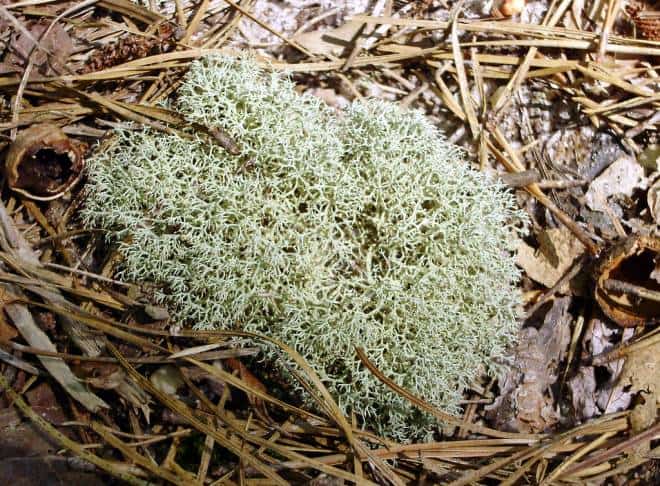Anywhere you go in the world, especially in forests and other wooded areas, moss is going to be a feature. Growing in a carpet-like fashion over the ground, tree trunks, fallen logs, rocks, and more, it is usually found in moist, shady areas without much foot traffic.

Come to think of it, that sounds a lot like the growth pattern of different kinds of fungi. Is moss actually a fungus?
No, moss is not a fungus. Mosses are plants, belonging to the Bryophyta division, where fungi and similar organisms are eukaryotes. Though they sometimes look similar, they are completely distinct biologically.
Many kinds of moss along with several kinds of fungi tend to grow in a mat-like arrangement along different surfaces out in nature, and sometimes along man-made structures. But, truly, that’s where the similarities end…
Biologically, they could not be more different and they actually belong to two different natural kingdoms! In any case, if you want to learn more about moss you’ve come to the right place. I’ll tell you a lot more in the rest of this article.
Moss is Different Than Most Other Plants
As mentioned above, moss is indeed just a type of plant, but it’s a really special kind of plant. Moss as a whole, lacks roots and is non-vascular, though they typically consist of many tiny individual leaves.
Because they lack a vascular system like most other plants, they cannot transport moisture and nutrients throughout their entire structure.
This means they have to absorb food and water directly from the environment, though they do photosynthesize as normal.
Mosses depend on special structures called rhizoids to anchor them in place and also help absorb moisture. Most interestingly, mosses lack flowers entirely, meaning they don’t reproduce like most other plants. Instead, they reproduce using spores and structures called capsules.
What Color is Moss?
Often shades and tones of green, but moss can come in a wide variety of colors. Depending on the season and what variety it is, you might see brown, red, purplish, yellow, and more.
How Does Moss Differ from Fungi?
Significantly. Both classes of organisms rely on spores for reproduction, but aside from superficial physical similarities in shape, color, texture, and the growth habit that is where the commonality ends.
For starters, moss is not parasitic and it does not break down and cause the decomposition of the materials and structures that it grows on.
Most kinds of fungi and molds particularly, do. Fungi need to break down organic matter in order to feed themselves, whereas moss can simply subsist on light and whatever moisture and other nutrients it can gather from what it is in contact with.
The tendency of moss to collect and hold on to moisture means that it can result in the incidental decomposition of whatever it is growing on.
This is why you don’t want to leave moss growing on a shingle roof, for instance, or on wood siding. It leads to constant dampness and that dampness can result in decay.
Coincidentally, that can open the door for fungus and other microorganisms to further speed decomposition!
Is Moss a Kind of Mold?
No, it isn’t. Mold is a kind of fungi, not moss and moss is entirely distinct from fungi categorically as we have learned. However, moss and certain types of mold may be mistaken for one another as described above.
Is Moss the Same Thing as Algae?
Another common point of confusion, but no, it isn’t. However, we have finally reached some significant overlap biologically even though they inhabit two different kingdoms.
Moss and algae are both considered simple kinds of plants, meaning no vascular tissues, no roots, no flowers for reproduction.
Structurally, the two are quite different even though their colors might be very similar. Alga always grows as a visually indistinguishable mass or clump-like structure with no recognizable individual parts, unlike the many varieties of moss.
You can also count on algae forming in, on, or very near water, whereas moss lives on land and grows on solid surfaces even though it prefers damp conditions.
Is Moss Dangerous?
No, it isn’t. However, that doesn’t stop people from destroying it when they mistake it for something that’s potentially dangerous like mold or some other kind of fungus.
Contrary to urban legend, moss is not a generator of lethal bacteria, and moss spores are not directly dangerous to humans, though some folks might encounter them as an allergen.
And mosses are nowhere near as destructive as mold and other fungi, save for their tendency to create constant dampness which can lead to decay as detailed above.
There are no known types of moss that are overtly poisonous or toxic to people, and they are safe to touch.
As always, though, they might harbor harmful bacteria and a subsequent infection has led to more rumor and legend about the supposed poisonous nature of moss. But, in the end, it is entirely harmless to people…
What About Reindeer Moss? It Doesn’t Look Like Moss
An interesting, and common question! Reindeer moss isn’t moss at all but a type of lichen.
Lichens are a type of composite organism, consisting of certain types of bacteria or algae that grow within the filament strands of certain kinds of fungus. Each organism in the relationship provides something that the other lacks in a type of symbiosis.
But lichens are not plants, though they often look like them and certain varieties, like Iceland moss, or wolf lichen can easily be mistaken for moss!
As you might guess, this adds an entirely new layer to the confusion around moss considering the naming convention and stark similarities in physical appearance.
Another thing to consider is that lichens might be the primary reason that some folks fear moss as toxic because there are some toxic lichen varieties out there.
As you might have already suspected, you should never eat any sort of plant or what appears to be a plant in the wild if you cannot 100% positively identify it!

My dad was military. My grandfather was a cop. They served their country well. But I don’t like taking orders. I’m taking matters into my own hands so I’m not just preparing, I’m going to a friggin’ war to provide you the best of the best survival and preparedness content out there.
